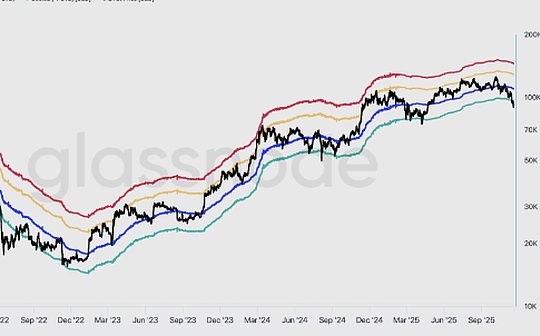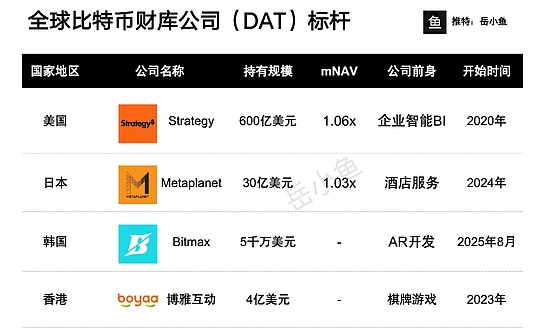
Author: Alex Thorn, Galaxy; Compiled by: Deng Tong, Bitchain Vision
The digital asset industry is about to usher in a golden age.U.S. cryptocurrencies may experience a whole new way of regulation, while new supporters will be welcomed by both houses of Congress and the White House.The industry demonstrates its political strength, sending a strong warning to its enemies in a way that will respond throughout the political field.The oppressive headwinds that have hindered industry development and increased legal fees in the past 4 years have weakened, and the cryptocurrency industry is now on a downwind trend in the world’s largest capital markets.
Election Night – Amazingly similar history
President-elect Donald J. Trump made history – becoming the second president ever to win a second non-sequential term.Grover Cleveland was the only one to achieve this in the former president, who defeated Benjamin Harrison in 1892 to win his second term.Then, counter-tariff, pro-gold Democrats returned to power in 1892 and received a second discontinuous term, while today, pro-tariff, pro-bitcoin Republicans won the second discontinuous term in 2024.History is often amazing.
Trump’s victory is also of historic significance in modern times.He will expand his electoral votes to more than 310 votes in 2016.He became the first Republican to win the nation’s majority popular vote since George W. Bush in 2004.Trump swept the “blue wall” states in Pennsylvania, Michigan and Wisconsin, just like in 2016, but he could also win Nevada, which Clinton won in 2016.In Florida, Trump won by a staggering 13%, although this performance can be largely attributed to population changes in the state’s past few election cycles.This heat map from Bloomberg shows more than 95% of reports in each county and changes in Republican and Democratic presidential candidates in 2020 and 2024.Too much red.
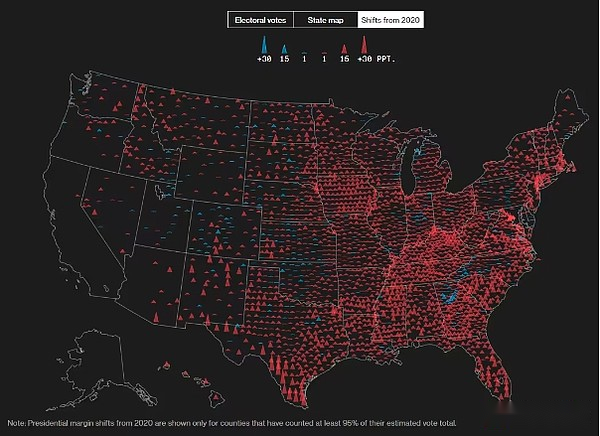
The Senate turned to the Republican Party, and the result was that the Republican Party controlled 54 seats.It will take longer for the House to know the outcome, but the Republicans are slightly dominant and are expected to maintain control over the House.
Some other key points of the election:
-
Cryptocurrencies demonstrate their political strength.In addition to a very public effort to get a broad and in-depth cryptocurrency agenda from President-elect Trump, the industry has gained extensive support in the House and Senate.The most eye-catching victory was Bernie Moreno (R-OH) defeating Sherrod Brown (D-OH).The cryptocurrency PAC spent tens of millions of dollars to beat Brown, the current chairman of the important Senate Banking Committee.Defeating Elizabeth Warren’s ally Brown sent a strong message that opposing cryptocurrencies are politically a failed stance.
-
Trump enters his second term.Presidents are known to solve more complex and distant problems during their second term.His victory also gave him more power than in 2016, with Trump taking office under the backing of one of the most diverse Republican voter coalitions in decades.This increases the possibility that Trump is committed to big ideas, which could include a significant modernization of the financial system.
-
Trump’s team is very supportive of the digital asset industry.Trump’s inner circle is very supportive of digital assets, many of whom have disclosed that they own Bitcoin.Vice Presidential candidate J.D. Vance disclosed that he owns Bitcoin, Vivek Ramaswamy has been an outspoken supporter of the industry throughout the campaign cycle, Robert Kennedy (RFK Jr.) owns Bitcoin, and has been very supportive for at least 2 years.Bitcoin, Howard Lutnick, co-chair of the transition team, said he and other Cantor Fitzgerald own “a large amount” of Bitcoin (Cantor banks hold Tether), and many other major donors are either directly involved in cryptocurrencies or performing on asset classes and industries.A clear positive attitude.Don’t forget that Trump himself has released NFT and launched his own affiliate DeFi protocol, World Liberty Financial.His team, family and donors’ affinity for cryptocurrencies increases Trump’s chances of fulfilling his campaign promises to the industry.
What to expect in Washington
Let me describe what might happen to crypto policies:
-
Banking regulator.Trump immediately appointed the new acting director of the Currency Complaint and the new acting chairman of the Federal Deposit Insurance Company.These institutions have prudent and supervisory authority over banks and depositary institutions.Perhaps within a few days, bank regulators can issue guidance that explicitly prohibit unfairly targeting specific industries (Chokepoint 2.0), and as Trump did when he first took office, they can certainly revoke existing matches.The industry’s adverse explanatory guidance or letter – i.e., the joint letter dated January 3, 2023.Within weeks or months, the Regulatory Commission may issue guidance that explicitly allows banks to custody digital assets and use, operate and interact with public blockchains and stablecoins.(Recall that Trump’s former acting auditor-general Brian Brooks issued such an explanatory letter in 2020).
-
Market regulatory agency.Trump promoted the current members of the SEC and CFTC to acting chairmen.While Trump promised to “fire Gary Gensler,” most constitutional scholars believe that the president cannot fire formally appointed commissioners from independent agencies.However, the President can immediately designate the current commissioner as the acting head of the agency.In the short term after such personnel changes, some cryptocurrency enforcement will be suspended, some litigation will be suspended or withdrawn, and no letter of action will be issued for a specific topic or project, and industries and regulators will have the opportunity to discuss a reasonable way forward.More comprehensive rulemaking will take longer, but the cryptocurrency industry may quickly obtain exemptions, with the main area being relaxing the SEC’s position on “securities” and “exchanges.”The CFTC has a similar position, but we will note that due to the lack of comprehensive market structure legislation to draw boundaries for clear jurisdictions between the SEC and the CFTC, there is a capacity to coordinate work and develop progress for both market regulators.The chair of policy will be very important.
-
Congress legislation.Congress’s largest crypto policy agenda items are well known: market structure (defining the regulatory status and supervisory bodies of digital assets) and stablecoins (legalizing the issuance of stablecoins and licenses).In May this year, FIT21 was passed in the House with a bipartisan majority and will at least form the outline of future market structure bill work.Currently, the two parties have relatively close positions on stablecoin legislation. The main disputes between the Democrats and Republicans regarding House financial services are 1) whether only the Federal Bank can issue it, or there are also state paths, and 2) which agency (or multiple agencies)) will assume prudent and supervisory rights for these issuers.
-
Crucially, if Republicans control the House, we think these bills are less likely to move forward rapidly in 2025.The unified Republican Congress may use the first 100 days of 2025 to focus on tax reform, trade and other issues—using budget coordination to drive Republican priorities.This doesn’t mean that crypto legislation is unlikely to make progress in the next Congress, but in a unified Congress we do think it will give way to other priorities – this requires close coordination between Congress and regulators on crypto policy.Our basic situation is that crypto legislation will move to the second half of the 119th Congress, giving cabinet officials and independent regulators a foothold before they engage with Congress on policy issues.
-
Energy policy.Trump’s election as president, especially if the Republicans control both houses of Congress, would be extremely beneficial to domestic energy and electricity production.This will benefit Bitcoin miners, data centers, anyone who can use a lot of electricity, and of course the energy producers themselves.
What does this mean for market participation
Relaxation of regulatory resistance, combined with specific letters of interpretation, non-action letters or regulatory guidance, could significantly expand US institutional investors’ access to cryptocurrencies.
-
The SEC relaxed the applicability of SAB 121 in September, or withdrawing that guidance altogether, which would pave the way for the world’s largest custodial banks to enter the cryptocurrency space.New York Mellon received waivers from heavy account guidelines because its main prudential regulator (NYDFS) did not object, but the OCC is the main prudential regulator for national banks such as Citigroup and JPMorgan Chase.Given that we are likely to see a significant shift in the OCC’s attitude to banks that interact directly with cryptocurrencies, these big banks will eventually have the opportunity to get more involved.
-
Further institutionalization will in turn increase financing options for crypto assets, making spot cryptocurrencies easier to obtain through existing institutional trading platforms and relationships, and improves the maturity of the institutional cryptocurrency market.
-
Relax the SEC’s applicability of Ouvian rules for digital assets, or expanding “crypto-asset securities” that can be traded within brokers/dealers, will allow more participants to enter the exchange field, which may include banks, transactionstraditional financial institutions such as offices or brokerage companies.Additionally, relaxing the SEC’s applicability to the Howie Rules could lead to more spot-based crypto ETFs in the United States.
-
Regulators’ clarity and tolerance may allow traditional financial services companies and investors to operate on-chain for the first time, bringing new opportunities for earnings and other strategies.
-
Expanding access to public blockchains may also revolutionize transaction efficiency, transparency, issuance and other aspects of finance.Under the regulatory situation and any legislation enacted, the merger of traditional finance and decentralized finance may eventually come.
-
Similarly, based on the SEC’s position on Howie and token disclosures, we may see a wave of new types of tokens, maybe even stock securities, while existing tokens may add more stock-likefunction to enhance its value proposition.The expanded and improved asset ecosystem will support the liquidity crypto hedge fund industry, which will continue to mature and expand its investment scope.Improved U.S. token disclosure and issuance capabilities will ultimately challenge and even reverse the existing SAFT-low floating high FDV system that benefits venture capital rather than liquid capital.
-
In terms of venture capital, the IPO market may be more meaningful to open to crypto-native companies, ultimately providing avenues for achieving return on investment through exits.Today, the only venture-backed crypto startup (except a few SPACs) to go public is Coinbase.We estimate that dozens of crypto companies may seek to go public in the United States if the conditions are right and regulators are open.
Bitcoin Market Analysis
Bitcoin was trading as low as $66,700 on Monday, November 4, but has since risen 15%, setting an all-time high.Bitcoin soared to an all-time high as Trump’s Nov. 5 win chances rose, and has since hovered in the $75-76,000 region.Despite the sharp fluctuations in prices – up 15% since Monday and 26% since October 1 – the market does not seem to be overheating on fundamentals.”Coinbase Premium” rebounded sharply on Tuesday night as Bitcoin rose due to election news, turning positive for the first time in at least a month.
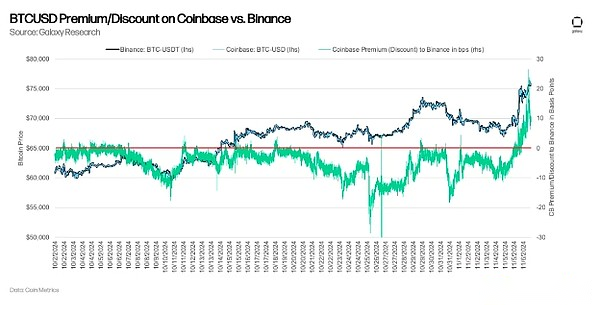
Bitcoin ETFs have been booming, with the largest net inflows in history on Thursday, November 7, with inflows of up to $1.375 billion, driving BTC to an all-time high.This figure surpassed the previous largest net inflow date March 12, 2024, when net inflows were $1 billion.
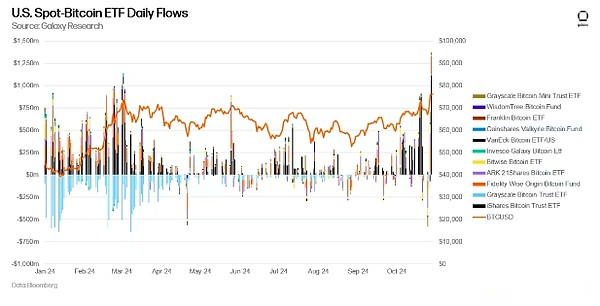
The cyclical nature of Bitcoin
Let’s review it,Bitcoin is on the track of the first two bull markets.Judging from cycle lows (2011: $2, 2015: $152, 2018: $3,122, 2022: $15,460), Bitcoin is on the track of the 2017 bull market, slightly behind the 2021 bull market.
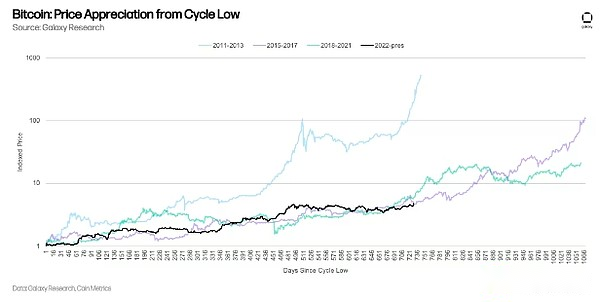
Looking back at the previous bull market pullback, the 2024 pullback was milder than the 2021 and 2017 bull markets.
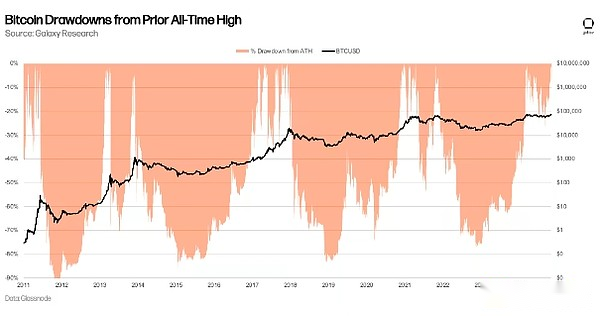
Futures and Financing
While futures open contracts on cryptocurrency exchanges rose slightly to annual highs, financing rates remained largely unchanged, suggesting that these trends were primarily driven by spot.
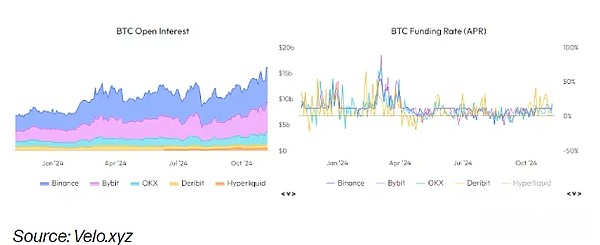
Bitcoin Options Market
Bitcoin options traders’ net short gamma is between $54,000 and $84,000, which will accelerate any movement.It should be noted that when traders short gamma, they usually hedge by buying spot when the price rises, or by selling appearances when the price falls.This effect can accelerate trends in either direction and increase volatility.Or, when traders short gamma, they do the opposite, sell when the price rises and buy when the price falls, thereby reducing volatility.Our analysis shows that the current short gamma peaks at $70,000, so this effect is declining as BTCUSD slowly moves higher.That being said, many call option holders in current high ranges are profitable, so these investors may decide to roll over higher strike prices, which will pull short gamma to higher strike prices.The following chart shows our views on gamma positions for all BTC maturities between November 7 and September 26, 2025.
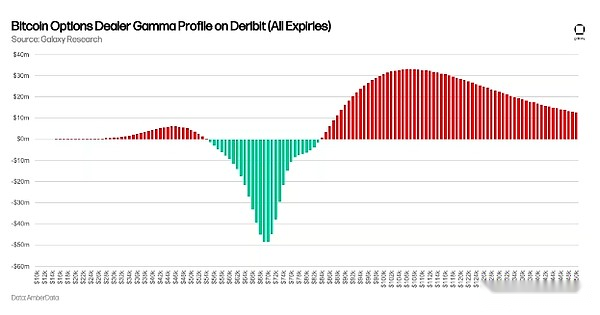
Basics of Bitcoin
The Achieved HODL Ratio is an indicator that measures the ratio between the 1 week and 1-2 years of realized market cap HODL range (the realized value of the tokens that moved during these time periods).A higher ratio indicates that the market is overheated, and the peaks tend to be consistent with the top of the market.The 2024 RHODL sideways are more reminiscent of the 2019-2020 sideways than any peak activity, which showsThere is still greater room for growth in the near and medium term.
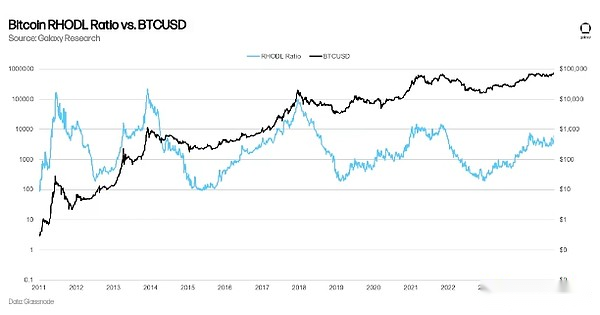
The MVRV Z score is the ratio of market value to actual value and the standard deviation of market value, which helps identify the difference between the value of an asset transaction and the total cost basis.Historically, this indicator has been very effective in identifying market peaks,The current value indicates that BTCUSD is not close to overheating or top area.
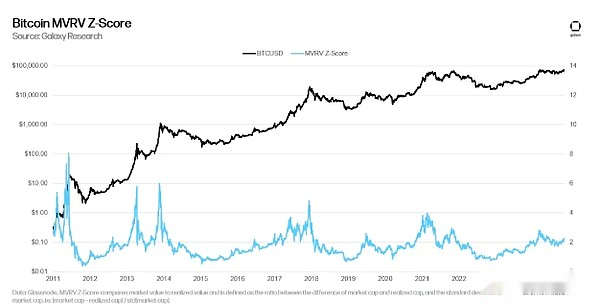
Bitcoin and Global M2
Bitcoin has historically responded to changes in global money supply.While this correlation is not unique to Bitcoin, it is still worth noting, especially if Bitcoin starts to be used more as a hedge asset as Larry Fink calls for.

Outlook
The incoming Trump administration, coupled with a strong Republican Senate, could confirm its appointed institutions, is beneficial to regulatory relief in the U.S. cryptocurrency industry.We expect all forms of exemption relief to be introduced soon, while a stronger supportive regulatory framework will take more time to emerge.A loose law enforcement environment coupled with progressive policy thinking will pave the way for traditional financial services companies and institutional investors to deepen their participation in asset classes.This will challenge the moat of existing crypto infrastructure players, but will also broadly support the expansion and maturity of asset classes.In this environment,We expect Bitcoin and other digital assets to trade prices well above today’s all-time highs over the next 12-18 months.
This report was originally sent to Galaxy customers and counterparties on November 7, 2024.


